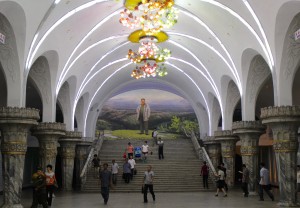Friday, April 29, 4:30 to 6:30pm, CWAC156
Revolution from 360 Ft. Below: On the Pyongyang Metro and the Problem of Ground
Douglas Gabriel
Ph.D. Student, Northwestern University

Among the deepest subway systems in the world, the Pyongyang Metro is marked by a radical disjunction with the space of the North Korean capital above it. Rather than referencing street names or landmarks above ground, each of the 17 stations on the Metro’s two lines is named after and elaborately designed according to a revolutionary theme, ranging from Camaraderie to Prosperity. Further, the Metro stations contain no maps of Pyongyang, and, in turn, city maps do not indicate the locations of the Metro stations. Frequently, the Pyongyang Metro is characterized as, on the one hand, a conspicuous form of propagandistic brainwashing, and, on the other hand, the result of a militaristic effort to conceal the locations of underground sites that could potentially serve as emergency bomb shelters. In contrast, this paper draws on visual evidence as well as previously unutilized primary sources in order to demonstrate that the bifurcation of the Metro and the city space stems from a highly singular understanding of the relationship between material reality and revolutionary ideas. I argue that the architectural design, lighting, sound, and mosaic murals of the Metro stations form a complex system of aesthetic effects aimed at suspending the North Korean revolutionary project within a dialectic of ground and transcendence.
Friday, April 29, 4:30 to 6:30pm, CWAC156
Persons with concerns regarding accessibility please contact xizh@uchicago.edu